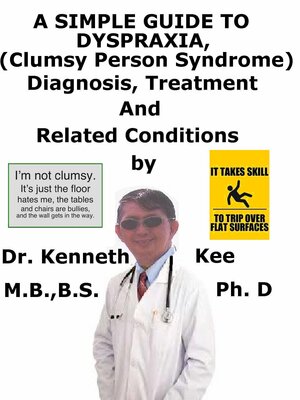A Simple Guide to Dyspraxia, (Clumsy Person Syndrome), Diagnosis, Treatment and Related Conditions
ebook
By Kenneth Kee

Sign up to save your library
With an OverDrive account, you can save your favorite libraries for at-a-glance information about availability. Find out more about OverDrive accounts.
Find this title in Libby, the library reading app by OverDrive.



Search for a digital library with this title
Title found at these libraries:
| Library Name | Distance |
|---|---|
| Loading... |
This book describes Dyspraxia, Diagnosis and Treatment and Related Diseases
"I am not clumsy! It's just the floor hates me, the chairs and tables bully me, and the wall gets in my way!"
Dyspraxia (Clumsy Person Syndrome) is a medical childhood disorder that produces poor coordination and clumsiness in people, especially in children.
6-8 % of children appear to have normal development but have difficulties with coordination and with learning new skills which affects their function at home, at school and in the playground.
Dyspraxia is a motor skills disorder with symptoms seen in children as young as 1-2 years old.
If the child has persistent clumsiness, gross motor movement and physical coordination, the doctor might decide on an evaluation for dyspraxia, a disorder with considerable ADHD overlap.
Children with dyspraxia appear awkward when moving their whole body, or use too much or too little force.
When a child has dyspraxia, he cannot imitate others, often mixes up the steps in a sequence, and can not come up with new ideas during play.
Dyspraxia is an unique but very similar diagnosis also linked with poor eye-hand coordination, posture, and balance.
Dyspraxia-related coordination difficulties affect all aspects of daily life such as brushing teeth, getting dressed, and doing laundry.
Dyspraxia is a brain-based motor disorder.
Dyspraxia involves fine and gross motor skills, motor planning and coordination.
While it can affect cognitive skills, it is not linked to intelligence.
Children who are born with dyspraxia will reach developmental milestones late and behave immaturely.
They can find it difficult to create plans and carry them out.
They may have difficulties in speaking and seem clumsy, leading people to call them by the outdated term "Clumsy Person Syndrome."
During adolescence and adulthood, children born with dyspraxia can develop learning difficulties and low self-esteem.
Dyspraxia involves about 5 to 6 % of the pediatric population and about 10 % of the population overall.
It is a lifelong disorder, and there is at present no cure.
There are effective methods, such as occupational and speech therapies, to successfully manage dyspraxia symptoms.
Developmental Coordination Disorder (DCD) and dyspraxia are two disorders that involve coordination in children.
Developmental Coordination Disorder (DCD) is a motor skills disorder that affects some children.
When a child has difficulties coordinating motor activities, they might be not able to perform everyday tasks.
This is due to a delay in the development of their motor skills.
Symptoms of DCD may involve:
An unsteady walk,
Difficulty going down the stairs,
Dropping objects,
Running into others,
Frequent tripping,
Difficulty tying shoes, putting on clothes, and other self-care activities,
Difficulty performing school activities such as writing, coloring, and using scissors
While DCD and dyspraxia sound similar, there is one main difference.
DCD is the formal term doctors use to depict children with certain developmental difficulties.
Dyspraxia, unlike DCD, is not a formal diagnosis.
Combining physical therapy with occupational therapy could improve the symptoms linked with both DCD and dyspraxia, such as tripping and difficulty performing day-to-day activities.
There are also other treatments for children with dyspraxia.
These involve speech and language therapy, behavioral treatment and psychological interventions.
An integrated treatment program that combines treatments such as academic...







